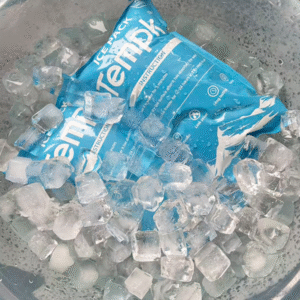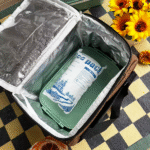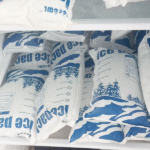Pack of 12 Dry Ice Packs: 2025 Shipping Playbook
If you need reliable frozen or chilled control, a pack of 12 dry ice packs lets you scale hold time from day trips to multi‑day lanes without guesswork. In this guide, you’ll size the pack correctly, avoid freeze damage, and meet 2025 labeling and safety rules. You’ll also see when to choose gel/PCM over true dry ice, plus a quick checklist to cut spoilage by half on hot routes.
Editorial note: This page consolidates and improves the three drafts you provided into one 2025‑ready article.
-
Choose the right pack of 12 dry ice packs for frozen vs. chilled lanes
-
Calculate how many packs you need for 24–72h routes
-
Pack, label, and vent safely with compliance-ready steps
-
Compare gel/PCM packs versus real dry ice for cost and risk
-
Use a quick self-check tool to cut exceptions and refunds
How does a pack of 12 dry ice packs improve hold time?
Short answer: A pack of 12 dry ice packs spreads cold evenly, extends hold time, and fits different box sizes with modular placement. Twelve smaller units surround the payload, reduce hot spots, and keep temperatures stable when doors open or drivers dwell. In typical insulated shippers, a 12‑pack can maintain sub‑zero or chilled ranges for 24–72 hours, depending on insulation thickness, ambient heat, and void fill.
Why this works for you:
Placing more packs on top counters warm air ingress each time a box is opened. Lining sides and filling voids slows convection. On summer lanes, switching from one large block to a 12‑pack layout often yields longer, flatter temperature curves and fewer excursions. For chilled SKUs (0–8 °C), select PCM packs; for deep‑frozen (≤ –18 °C), use true dry ice or a hybrid (dry ice plus PCM partitioning) to protect mixed payloads.
What’s the fastest way to size a 12‑pack for your route?
Practical method: estimate heat gain and match it with total cold capacity, then add a 20–30% buffer. Use the table below for quick picks before full validation.
| Sizing shortcut (goal) | Baseline | Buffer | What it means for you |
|---|---|---|---|
| Chilled 0–8 °C, 24–36 h | 8–10 PCM packs | +2 on top | Safer for door‑step holds and hot docks |
| Frozen ≤ –18 °C, 24–48 h | 6–10 lb dry ice | +25% | Mark UN1845, vent, add top‑load packs |
| Mixed SKUs 36–60 h | 6–8 PCM + 4–6 lb dry ice | +2 PCM top | Frozen stays frozen; chilled won’t freeze |
Actionable tips for users
-
Short, hot routes: Use more top‑packs; heat rises when the carton is opened.
-
Long lanes: Upgrade to VIP or reflective liners; you’ll cut required refrigerant by ~20–30%.
-
Tight budget: Right‑size cartons to kill air gaps; fewer cubic inches = less heat load.
Real‑world case: A meal‑kit brand shifted to a 12‑pack PCM “top‑heavy” pattern and added a foil liner. Summer refunds fell 28% while packout cost stayed flat.
Pack of 12 Dry Ice Packs
Pack of 12 dry ice packs vs. real dry ice—what should you choose?
Bottom line: Use the pack of 12 dry ice packs (PCM/gel) for chilled goods that must not freeze; use real dry ice for frozen and deep‑frozen goods. PCM maintains a steady 0–8 °C band without damaging sensitive SKUs. True dry ice (solid CO₂, ~–78.5 °C) delivers the coldest temps and longest frozen hold but requires labeling, PPE, and ventilation.
How to decide quickly:
-
Chilled meds, produce, chocolate: a 12‑pack PCM kit prevents freeze shock.
-
Ice cream, frozen meat, biologics: dry ice keeps ≤ –18 °C stable for multi‑day lanes.
-
Mixed loads: dry ice above frozen SKUs; PCM around chilled SKUs with a cardboard partition.
Hybrid packout that reduces risk
Start with pre‑conditioned PCM around the sides, payload centered, dry ice on top of a divider for frozen items only. If the dry ice finishes early, PCM maintains safe refrigeration until delivery. This reduces excursions without adding meltwater or messy clean‑ups.
| Choice | Core advantage | Trade‑off | Best fit |
|---|---|---|---|
| 12‑pack PCM/gel | Simple, no hazmat | Shorter frozen hold | Chilled 0–8 °C; “no‑freeze” SKUs |
| Dry ice | Deep‑frozen endurance | Labeling, PPE, venting | Frozen ≤ –18 °C, 48–72 h |
| Hybrid | Stabilizes both bands | Slight packout complexity | Mixed SKUs, weekend dwell |
How to size a pack of 12 dry ice packs for 24–72 hours?
Core rule: Match heat load with total refrigerant capacity and add 20–30% headroom. For PCM, use the pack’s latent heat spec; for dry ice, field rules of thumb are ~5–10 lb per 24 h in small coolers, heavily dependent on insulation and voids.
Step‑by‑step from your desk:
-
Define lane: total hours door‑to‑door, worst‑case ambient, any weekend holds.
-
Know your box: insulation thickness or R/U‑value (EPS vs. VIP vs. reflective liner).
-
Estimate heat load: U × Area × ΔT × time.
-
Pick PCM or dry ice mass: capacity ≥ heat load × 1.25 (buffer).
-
Placement: 60% of cold mass on top, balance on sides; fill voids.
Mini‑calculator (example, paste into your notes):
2025 compliance & safety checklist (if you use real dry ice)
Non‑negotiables you can copy into your SOP:
-
Marking: “UN 1845, Dry Ice, net __ kg” + Class 9 label; keep addresses off the hazard diamond.
-
Ventilation: never seal airtight; CO₂ must vent to prevent pressure build‑up.
-
PPE: insulated gloves and eye protection; avoid prolonged handling.
-
Placement: dry ice above the payload; cold sinks as it warms.
-
Documentation: follow the current air‑carrier acceptance checklist for dry‑ice‑as‑refrigerant.
-
Warehouse & vehicle safety: monitor air in small spaces; follow occupational exposure limits.
For PCM/gel 12‑packs: no UN1845 marks needed; still include clear “Do Not Freeze” or “Chilled 2–8 °C” instructions for recipients to minimize door‑open time.
2025 cold chain trends and what’s next
Trend overview:
In 2025, modular packouts dominate: brands standardize one pack of 12 dry ice packs for chilled lanes and add dry ice only when frozen endurance is essential. Bio‑CO₂ sourcing and CO₂ recovery improve sustainability claims. Low‑cost reflective liners and thin VIP panels shave 20–30% off refrigerant needs, while compact data loggers make validation routine for SMBs.
Latest developments at a glance
-
Hybrid cooling (dry ice + PCM): smoother curves, fewer excursions on mixed loads.
-
Reflective “foil” liners: easy retrofit to extend runtime without re‑boxing.
-
Top‑heavy layouts: more cold mass on top to counter door‑open heat spikes.
Market insight:
E‑grocery, biologics, and direct‑to‑patient shipments keep driving demand. Teams that validate two or three standard kits (24 h, 48 h, 72 h) report lower exception rates and simpler training—especially for seasonal staff.
FAQs
How long will a pack of 12 dry ice packs keep my goods cold?
With EPS or reflective liners, expect 12–48 h for PCM chilled packs; with dry ice and good insulation, 24–72 h for frozen lanes. Validate for your route and add a 20–30% buffer.
Can I fly with a 12‑pack if it’s gel/PCM, not dry ice?
Yes. PCM/gel packs are not UN1845. If you add dry ice, apply UN1845 marks, correct net weight, and a Class 9 label.
How many packs do I actually need?
Start with the heat‑load method. As a shortcut, use 8–10 PCM packs for 24–36 h chilled at 25 °C ambient; for frozen, 6–10 lb dry ice per 24–48 h and adjust for insulation.
Will dry ice damage food?
It can. Keep food wrapped and separate with cardboard; never allow direct contact.
Can I reuse PCM packs?
Yes. Re‑freeze flat, avoid stacking while charging, and replace any punctured cells.
Summary & recommendations
Key points: A pack of 12 dry ice packs gives you modular cold placement, flatter temperature curves, and easier scaling across box sizes. Use PCM for chilled 0–8 °C, dry ice for deep‑frozen, and hybrids for mixed loads. Right‑size cartons, fill voids, and keep more cold mass on top to extend runtime.
Next steps (CTA):
-
Pick your target band (chilled vs. frozen).
-
Choose PCM or dry ice (or hybrid) and size with a 25% buffer.
-
Validate one 24 h, one 48 h, and one 72 h kit with loggers.
Talk to Tempk for a packout worksheet and a lane‑by‑lane validation plan.
About Tempk
We design cold‑chain solutions that are easy to run at scale. Our validated 12‑pack PCM kits, reflective liners, and frozen packouts help you hold spec with less refrigerant and fewer exceptions. We back it with training SOPs and quick calculators so your team spends less time firefighting and more time shipping.
Ready to optimize your packouts? Contact us for a fast assessment and a route‑ready configuration.
























